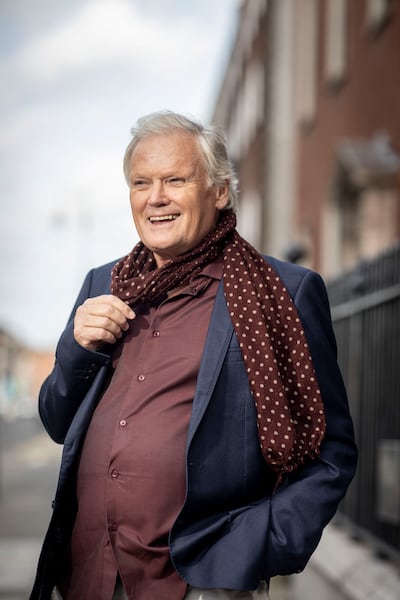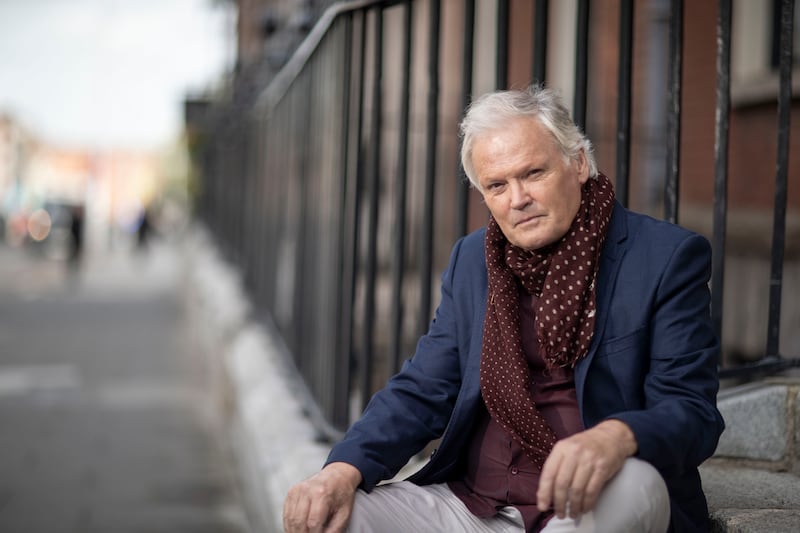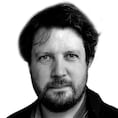The clinical psychologist Dr Tony Bates thanks the waitress as we pay for our coffee in the Merrion Hotel. “Carmeline,” he says, reading her name tag.
“Actually, I’m Caroline, I lost my badge and they gave me a fake name,” says Caroline/Carmeline.
“So you’ve a false identity,” says Bates. “You’re not yourself today.”
“Yes, I’m Carmeline,” says Caroline.
READ MORE
“Chameleon,” says Bates, smiling. “That’s a good name.”
Sometimes reality is very on the nose. Bates and I have been talking about the masks people wear to hide their pain. Reality has also conspired to give him, a professional listener, an ear infection which means he has to lean in to hear more clearly. When I tell him that, like him, I was born in Cork to an army family, he leans in and says, warmly, “Sure we’re related already.”
Bates has a lot to say in his book about the state of contemporary mental healthcare. He has the pedigree for this. He’s adjunct professor of Psychology at University College Dublin. He was formerly head of the Department of Psychology at St James’s Hospital. He established the MSc in Cognitive Psychotherapy at Trinity College Dublin and created Jigsaw, The National Centre for Youth Mental Health. He has written for this newspaper and appears on the Brendan O’Connor Show on RTÉ Radio 1. Sometimes neighbours who know his profession ask him for psychological insights. He refers to a recent “clinic” he held while buying a newspaper. “It’s meeting a moment and it’s real.”
Bates didn’t choose the Merrion Hotel for our meeting randomly. “I spent 10 years of my life here,” he says. “This was the orthopaedic hospital. I used to come here with my mother from age 3 or 4. And we’d go downstairs, which is not the cellar bar. And I’d get examined ... I had, problems, ‘funny legs’ ... I had calipers up to my knees.” He recalls visiting a clinic in a Portakabin out in what is now the hotel’s picturesque courtyard when he was a little older. “I can still remember the smell of feet.”
The risk is that people grow into diagnostic labels, that they become a kind of a statement of their identity
This is all relevant to his new book, Breaking the Heart Open: The Shaping of a Psychologist, in which Bates writes in moving detail about his own childhood traumas and issues with depression. The most formative events came when he was turning three. His brother Jim died from measles at just 16 months and very shortly afterwards Bates himself was hospitalised with a near-fatal illness after which he was sent to live temporarily with relatives. Only later did he learn about this and understand how it left him grappling with pain and loneliness into adulthood. “I experienced it as a partial abandonment and rejection, and therefore I was no good. Because clearly, it wasn’t my parents’ fault. It was mine. I had obviously done something. So that left me with a default position: If anything bad happens, first and foremost, I did something wrong.” He laughs and points to his sore ears. “I kept saying to [the doctor], ‘Did I cause this?’”

Bates had a serious depressive episode in his early 30s while working and completing his PhD in the University of Pennsylvania. The trigger seems innocuous (he missed an opportunity while purchasing a home for his young family) but it was really about this early life experience. His mother had recently written to him explaining what had happened. “What happened to me happened at a time before I ever had words. So I had no words for the memories ... I just felt a scarring inside me, a knife cutting through me, sensations of profound pain that I couldn’t articulate or express and I did everything to subdue and calm through smoking, drinking.”
The book is painfully honest. He describes his distress at different points in his life, how as a young child he would run around his room naked, biting himself. “I had no idea why I was doing that.” For a while as a young man he thought he’d found answers in religion. He recalls meeting his aunt, a nun, and just babbling “gobbledegook ... And she listened calmly. I think in that moment, I learned how to be with psychotic people. I think she modelled it for me. I tried, later on, to remember that calm and that steadiness, knowing that behind all of the verbal confusion and irrationality there’s a human being who’s holding on.”
Does he think most people who work in mental health fields have had their own issues with mental health? “I think that the inner world has to be something we’re concerned about ... Our own vulnerability is the only thing that gives us a way into the lives of people who are troubled. Mine gave me a great edge. I had no trouble being around psychotic people or people who were suicidally depressed. I was completely calm and at peace. [It] felt like familiar terrain.”
The personal revelations in the book are interspersed with his developing thinking as a psychologist. He discusses the outset of his career in the 1970s when he worked St Brendan’s in Grangegorman when “the role for psychology was very underdeveloped” as well as his subsequent psychotherapeutic training and the various benefits of cognitive behavioural psychology (which he learned directly from its creator, Aaron Beck), psychoanalysis and mindfulness. He also takes inspiration from literature. “I feel that ... there’s far more human psychology there than in our health service.”
He’s pleased at how some of the stigma around mental health issues has lifted but he’s troubled by the medical, psychiatric model that often dominates the discussion. “I think we’ve come to look at emotional distress of any kind in terms of psychiatric language.”
Kids have TikTok. They have language. It’s not unusual for young people to come in and say ‘I’m having attachment issues’ or ‘I’m dysregulated’
He feels that while psychiatric diagnoses can provide useful descriptions, they’re often poor explanations for people’s distress. “I’m depressed. Why am I depressed? Because I have depression. How do we know that? There’s no blood test, biological marker, no evidence ... So how do I know? We go back to the description. You have depression because you’re feeling this way. It’s circular ... I think there are other ways to think of human suffering other than psychiatric language.”
He is not downplaying the level of distress people feel, nor saying that people don’t need the help of trained professionals and access to supports and resources. “People get horribly depressed and sad and hurt and they’ll do anything to get away from that feeling. They’ll go mad. They’ll take their lives. They’ll think about taking their lives. They’re driven to extremes by those feelings. And it’s frightening.”
[ Number of children using clinical psychology services increases by 150%Opens in new window ]
And he understands that a diagnosis, in this context, can often come as a relief to people. “I met a woman two years ago and she told me quite confidently that she’d been diagnosed bipolar after many years of trying to get help, and I asked her, ‘What does it mean to you?’ She said, ‘It’s a way of saying to people, I’m hurting, without having to go to the whole complicated story of my early life.’ And that was beautiful. I wouldn’t take that from her. Because for her, that was the story she needs to hold her own dignity and to own her own vulnerability.”
(He also notes that medication often has an important role to play. “It can be life-saving and nothing I’m saying in the book is in any way suggesting people should discontinue medication.”)
But he is increasingly worried by the extent to which distress is pathologised. “Kids have TikTok. They have language. It’s not unusual for young people to come in [to Jigsaw] and say ‘I’m having attachment issues’ or ‘I’m dysregulated’ or the person who said, ‘I know what’s wrong with me, I have a borderline personality disorder.”

Again, he acknowledges that these young people are often dealing with significant emotional pain. “I think that they’re facing far more expectations on very different fronts academically, from family, from peers, in terms of appearance, all the usual things ... Many of them just find the demands exceed their capacity.”
But he worries that diagnostic labels can be restrictive. “The risk is that they grow into them, that [they] become a kind of a statement of their identity. So in a funny way, they can get stuck. And I think that if they could see those identities as a skin, like a snakeskin, that you could shed at 21, and move into something else, that’d be great. But I’m concerned that that isn’t what happens. [And] every time a medical report is sent from one doctor to the next ... They see it as a past psychiatric history and that frames how they’re perceived and treated.”
Part of his discomfort is that he distrusts the certainty of some diagnoses. “There is a delusion that we understand depression, or psychosis or anxiety,” he says. “But if you meet one depressed person, you’ve met one depressed person. If Patrick turns up depressed, that’s a whole new story. It’s a whole new set of variables ... The people I admire [in the mental health sector] don’t claim to have easy answers. Talk to patients in some of our flagship mental health centres and they will tell you, it wasn’t [always] the consultant who helped it was the nurse who really got them ... We need people who can just listen, and don’t believe they have to fix everybody or that they know everything.”
He tells, by way of example, a story about his late friend, the highly respected psychiatrist Anthony Clare. “I sent a person, early 20s, drinking too much, marital problems, running away from his difficulties, to see Tony Clare, who saw him for an hour ... I met him a day or two later. ‘How’d you get on?’ He said ‘[Clare] was absolutely terrible, no good at all.’ I said, ‘Really? I’m surprised.’ He said: ‘I had to do all the talking. He said nothing.’”
What would he like to change about the system? “I’d like the point of sale to be one where people are genuinely respected and listened to when the distressed person comes to a mental health worker, it could be the receptionist or the consultant,” he says. “I’d like if there was a real effort to co-create with someone a story, a real story, of what has happened to them, rather than try and identify what’s wrong with them ... I’d like the whole issue to be lifted out of this intrapsychic, individualistic frame and I’d like their life to be seen in context, in terms of history, and also their current social context; if they’re homeless, if they’re coping with unaffordable rent, if they’re in a domestic violence situation. There are many reasons why they might be depressed. And these need to be looked at ... Fintan O’Toole made a comment in the Galway Arts Festival some years ago that we have ‘over-privatised’ mental health. And what he meant is we’ve made [the diagnoses] much more individualised when it’s actually much more social.”
He expects some to strongly disagree with his critique of the psychiatric model in the book (although he quotes many psychiatrists who agree). “They’ll push back that emotional distress is mental illness, and that it’s an illness that they can treat and they alone understand. And yes, they know there’s lots of things go into [mental health] and they’ll claim to be adherent to the ‘biopsychosocial’ model [that takes account of biological, psychological and social factors]. But as the president of the American Psychiatric Association said a few years ago, ‘we talk about the biopsychosocial model, but let’s face it, we’re bio-bio-bio.’ And so they will push back. Because if it’s not medical, where does that leave us? Who’s in charge? ... For psychiatry that’s a very threatening experience.”
Nowadays, he still looks at his life as a “work in progress”. He lives in a bungalow in Sligo where he gardens and looks after rabbits and hens while looking out on the Atlantic. He shows me a photograph of the view from his shed. He likes solitude and says that he and his wife Ursula “have found a rhythm around that”. He was very careful, he says, not to breach the privacy of his family in the book (he has three children and five grandchildren). “Here’s the thing, just because you have trauma in your life doesn’t make you a nice person. If you’re hurt you pass that on. [The psychoanalyst] Alice Miller [says] when you’re carrying hurt and you’re not dealing with it, somebody else is paying the price ... I have no doubt [that] my hurt, hurt Ursula over many years.”
They’ve done a lot of therapy together, he says. “I think we’re at a place now where we don’t have to apologise that we live in a certain way. She introduced me recently as her ‘semidetached husband’.” He laughs. “My son read the book and gave me perhaps my biggest compliment that I’ll ever get from it. He said to me, ‘You were in a lot of pain. And we didn’t know.’ ... I think Ursula and I contained a lot.”
[ How can a person know what kind of therapy they need?Opens in new window ]
What was it like to write about this now? “We all have to come home to ourselves at some point,” he says. “For me, growing up was about becoming more honest and open. And I think the book is the culmination of that in some ways. And it was quite a challenging experience and quite an emotional experience, at times, writing through tears.” A little later he says: “Moments of crisis and pain, I have great respect for them in people’s lives ... They need great care but there are moments when a person [realises] ‘I don’t want to continue this way.’ ... These moments of crisis, they’re doors, inviting them to walk through.”
Breaking the Heart Open: The Shaping of a Psychologist by Tony Bates is published by Gill (€22.99)




















